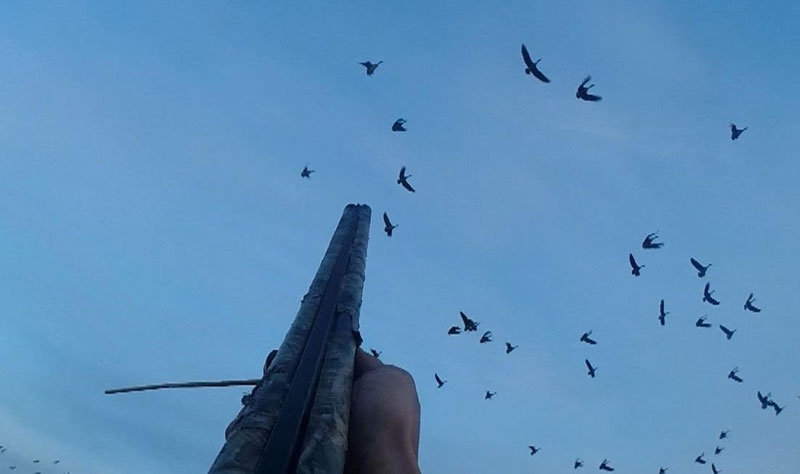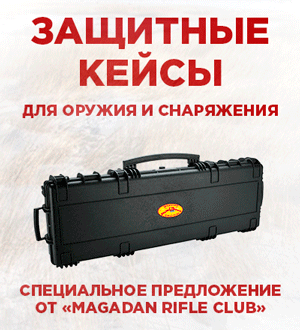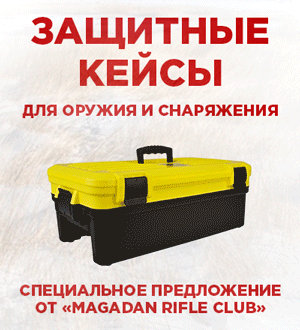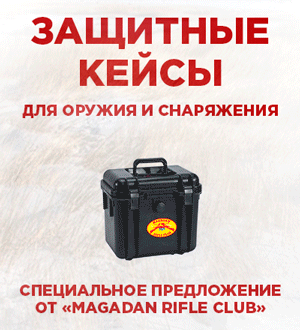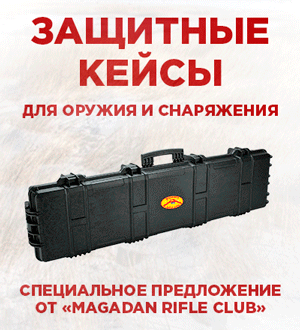Posted on March 13, 2017
Ocular measurement of distance

Modern shotguns, intended for use for hunting hunting, as a rule, reliably hit the target at a distance of not more than 50 meters. However, you can not shoot them at a distance closer than 20 meters, even from barrels with a cylindrical drill. The explanation is that at a distance less than 20 meters, the shot from the barrel flies too much, therefore, it is difficult to get into the mobile target. Whereas, at a distance of more than 50 meters, the accuracy already becomes insufficient to reliably hit the game.
That is why, the most convenient distance for firing a shotgun from a rifle of 16 caliber, is called the distance from 23 to 30 meters, with cylindrical drilling of trunks, and from 30 to 35 – for barrels with muzzle constriction. This, of course, is the average rate for a gun, which can vary in one or another line depending on the number of fractions and the size of the game itself, but they can be taken as a basis. About this in more detail and what is the ocular measurement of distance, why it is necessary for the hunter – is told in this publication …
The key to a successful shot
In order to make a successful shot, the shooter must catch the moment when the game will be from him at a certain distance. Outside this distance, the effectiveness of the shot is sharply reduced. Since, from a shotgun, as a rule, they shoot at mobile targets that appear suddenly and just as quickly leave the reach of the gun, the question of eye estimation of distances becomes paramount for hunters.
The moment the game appears, the shooter estimates the distance to it not in meters or in steps, but on a much simplified scale. As a rule, in the consciousness of the arrow, the distance to the game is divided into the following zones:
- Too close, you can not shoot yet, which roughly corresponds to a distance of 0 to 20 meters,
- You can already shoot – the distance from 20 to 30 meters,
- Just – the distance from 30 to 40 meters,
- You can also shoot – the distance from 40 to 50 meters.
Also, sometimes arrows may try to get into the game, although they realize that theoretically this is already impossible.
Despite the strict approximation of such an assessment, it requires the shooter to have a good skill and to fully use all the possibilities of his visual apparatus.
Methods for determining the distance to game
Determining the distance to the game, when it moves quickly, and even more so – is in the air, it is possible with the help of one of the following methods:
- According to the state of convergence of the eyes,
- By the relative, apparent magnitude of the target itself,
- According to the degree of visibility of game, feathers, ears and similar small details.
Convergence features
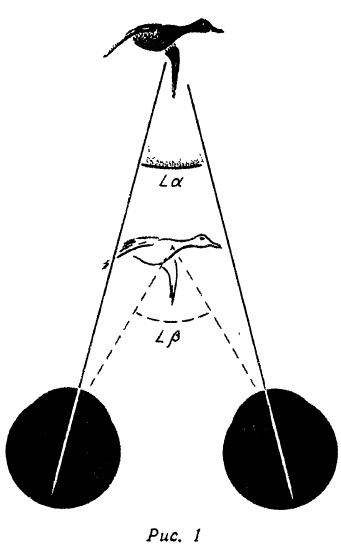 When examining any object, a person sends both eyes to him. In this case, the eyes rotate in orbits until the lines meet on the subject under consideration and the image of the latter does not lie on the so-called central fossa of the retina. This process of reducing eyes is called convergence. Naturally, the degree of convergence measured by the angle between the visual lines (angles A and B in pic. 1) depends on the distance between the observer himself and the subject he is observing. The closer the object, the stronger the convergence – the angle B is greater than the angle A, with each distance to the object corresponding to a certain position of the eyes, a certain value of the convergence angle.
When examining any object, a person sends both eyes to him. In this case, the eyes rotate in orbits until the lines meet on the subject under consideration and the image of the latter does not lie on the so-called central fossa of the retina. This process of reducing eyes is called convergence. Naturally, the degree of convergence measured by the angle between the visual lines (angles A and B in pic. 1) depends on the distance between the observer himself and the subject he is observing. The closer the object, the stronger the convergence – the angle B is greater than the angle A, with each distance to the object corresponding to a certain position of the eyes, a certain value of the convergence angle.
Experience with stereoscopic range finders shows that a person notices the relative displacement of images in the right and left eye, when it is reached 10-12 angular minutes. Also, there is reason to think that when the distance is changed, the new position of the eyes comes after the relative displacement of the images has reached the same value at 10-12 arc minutes. If this value is taken beyond the accuracy of the information we obtain, convergence in determining the distances should play a leading role, at least up to 100-150 meters. But, it is worth remembering that with increasing distance, the accuracy of its definition by the sense of convergence is rapidly decreasing.
In order to see how important the role in assessing distances and in general, in orientation in space, is the ability of a person to reduce the visual lines of the eyes to the subject, it will be enough to put a bandage on one eye and go out into the street. Within a few days a person will feel helpless or confused.
Image size analysis
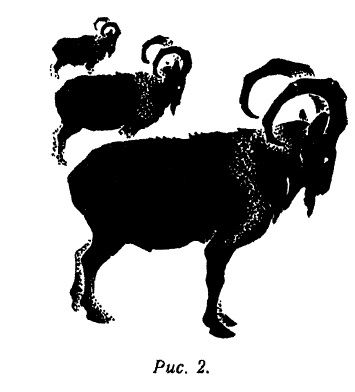 The second way to judge the distance is the size of the images of the subject under consideration, which are formed on the retina of the right and left eyes. The further the object is from the observer, the smaller his images are obtained, moreover, this decrease is proportional to the distance. So, if you stand at a telegraph or telephone line, and look at the outgoing pillars, you can clearly see the above position. Looking at pic. 2, you can also say that the second goat is twice as big as the first one, and the third is twice as far as the second …
The second way to judge the distance is the size of the images of the subject under consideration, which are formed on the retina of the right and left eyes. The further the object is from the observer, the smaller his images are obtained, moreover, this decrease is proportional to the distance. So, if you stand at a telegraph or telephone line, and look at the outgoing pillars, you can clearly see the above position. Looking at pic. 2, you can also say that the second goat is twice as big as the first one, and the third is twice as far as the second …
If the observer has information about the actual value of the object, or rather, he remembers how large he seems to him at a distance of 10 or 20 meters, he can judge the distance to this object, however far away from him Was not. Theoretically, this method of estimating distances may be more accurate than the previous method described by us. In addition, within the scope of this method, it is possible to judge both small and significant distances.
Meanwhile, in most people the ability to determine the distance by the apparent magnitude of objects, more precisely – by the magnitude of their image, is secondary, spare. And, only in case of loss of one eye, the dormant ability wakes up and replaces the main one. How complete this substitution can be, can be judged by how people who have lost one eye can be great arrows, swordsmen and even drive vehicles.
Since the estimation of distances according to the apparent magnitude is usually underdeveloped, the transition from a binocular two-eyed vision, as mentioned above, to a monocular, one-eyed view, leads a person to a state of misinformation. So, throwing up a gun and covering one eye, many hunters cease to feel the distance to the game. In addition, the transition to monocular vision is associated with another unpleasant phenomenon, which is called a microscope. This is when things start to appear smaller than they seemed with binocular vision. Therefore, in persons shooting with a single covered eye, sometimes there is a feeling that the bird is outside the area of the shot, and they lower the gun. Having lowered it and having looked at the game with two eyes, they understand that in fact, the game is at a distance necessary for carrying out the right shot.
Great help in determining the distances to the target according to the apparent values of the game can be rendered by sighting devices – a rifle front sight, a bar, a sight, a grid of an optical sight.
All these standards are with the throwing gun always at the same distance from the eyes of the arrow, and therefore their image on the retina is always the same size. In other words, the shooter sees them the same size. Therefore, the apparent and constantly changing amount of game can be compared with the constant value of sighting devices. It is necessary only in advance to calculate the size of the projection of the game, referred to the plane of the sight.
For example, you need to know the magnitude of the projection of the mallard, which flies at a distance of 40 meters, and carry this projection to the plane of the fly. To do this, you need to know, firstly, the length of the mallard’s body, for example it can be 54 centimeters, and secondly the distance from the arrow’s eyes to the flies of its gun. Assuming that the latter is 90 centimeters, from the similarity of the triangle AOB it will not be difficult to find the size of the projection of the target:

In other words, the silhouette of the transversely flying mallard, which is 30 meters from the arrow, will be 3 times longer than the width of the strip – approximately equal to 5 millimeters, and slightly smaller than the diameter of the trunk. In the same way, you should calculate the relative size of the mallard at distances of 20 and 50 meters.
Accounting for the degree of visibility of parts
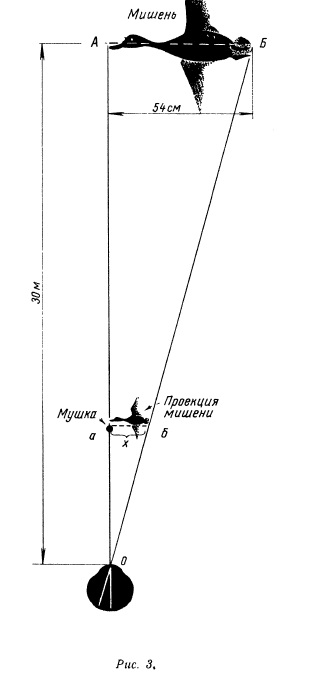 The third way to determine distances is to take into account the degree of visibility of details, for example, eyes, ears, individual parts of the tail. It is based on the fact that it is possible to distinguish these details only when the dimensions of their images reach a certain value, which in turn depends on the distance. It should not be forgotten that, regardless of the magnitude of the images in clear sunny weather, the details of objects or targets are generally better seen than in a fog or in twilight. The visibility of the details depends also on which side the light falls on the target. Because of this, the appearance of the elements of the goal in most cases deceives people and misinforms them about the actual distance to the subject they are considering.
The third way to determine distances is to take into account the degree of visibility of details, for example, eyes, ears, individual parts of the tail. It is based on the fact that it is possible to distinguish these details only when the dimensions of their images reach a certain value, which in turn depends on the distance. It should not be forgotten that, regardless of the magnitude of the images in clear sunny weather, the details of objects or targets are generally better seen than in a fog or in twilight. The visibility of the details depends also on which side the light falls on the target. Because of this, the appearance of the elements of the goal in most cases deceives people and misinforms them about the actual distance to the subject they are considering.
In those cases when the animal is on the ground, especially if it lies motionless, the distance to it can be judged by the local objects filling the space that the arrow and the target share. As a rule, this is done subconsciously, but the results are much more accurate if it is done according to a certain system. It is worth to preliminarily measure 10 or 20 meters and remember well the local identification marks – stones, hummocks, bushes. When it becomes necessary to measure the distance, it will not be difficult to estimate this segment mentally and postpone it several times from one’s legs to the animal, taking into account, of course, perspective shortening.
When estimating distances on the plain, the sense of the inclination of the head and the visual lines relative to the horizon line plays a significant role. The closer the object is to the observer, the lower his eye should be lowered and vice versa.
How to train the ability to determine the distance
All described methods of estimating distances are based on a constant comparison of various sensations with subsequent experimental verification of the actual distance. Usually all this takes place subconsciously, but if you approach purposefully with distance estimation, you can achieve very good results.
It is also important to enrich your memory with data on the position of the eyes and head, the relative magnitude of objects that correspond to strictly defined distances. This is achieved as follows. You select a point and first estimate the distance to it in steps or meters, and then check the distance by counting the number of steps. By the end of the check in memory, you will still have fresh sensations that you experienced during the eye assessment. This training should be done as often as possible, and not only in the forest, but also in the city.
Persons who cover one eye while aiming can be recommended to go to shooting with both eyes open, and if this is impossible for some reason, then, to train in determining the distances, looking not only with both eyes, but also with one, that is the one.
The post is prepared from the materials of B. Martino, taken from free sources.
Sources: bighunting.ru



